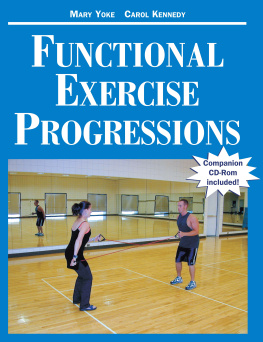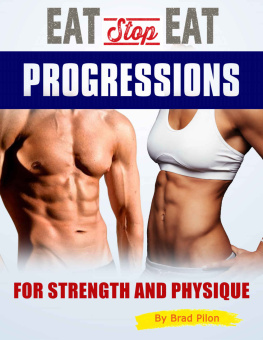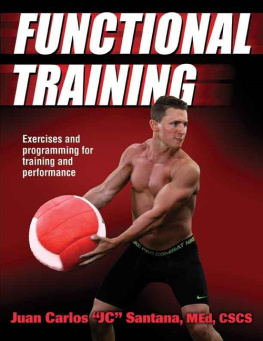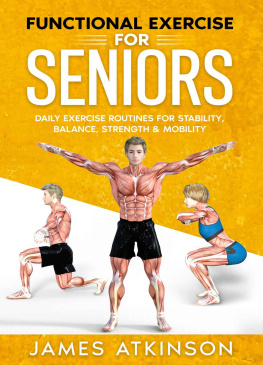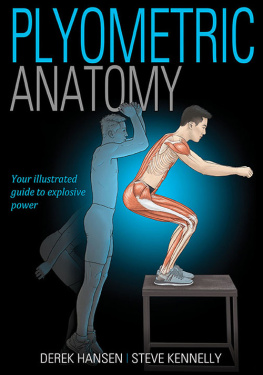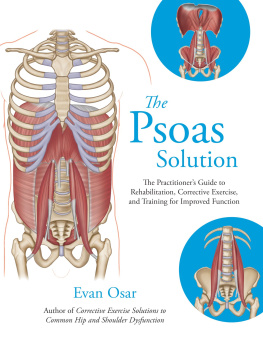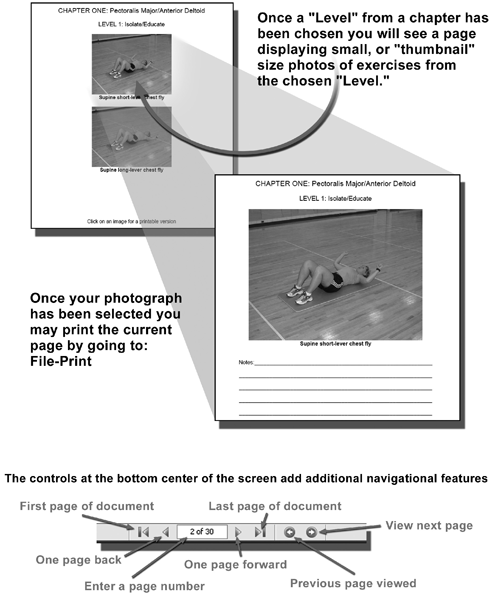Functional Exercise Progressions
Mary Yoke, MA
Carol Kennedy, MS
2004 Healthy Learning. All rights reserved. Printed in the United States.
No part of this book may be reproduced, stored in a retrieval system, or transmitted, in any form or by any means, electronic, mechanical, photocopying, recording, or otherwise, without the prior permission of Healthy Learning.
Throughout this book, the masculine shall be deemed to include the feminine and vice versa.
ISBN: 978-1-58518-998-4
Library of Congress Control Number: 2003106969
Book layout: Jennifer Bokelmann
Cover design: Kerry Hartjen
Text and cover photos: Ryan Rudd
Illustrations: Clint Smith. Used by permission of E2 Systems, Inc. Pages 13, 21, 29, 37, 45, 53, 63, 79 (top and middle), 97 (bottom), 105
Jeanne Hamilton Pages 71, 79 (bottom), 89, 97 (top), 113
Healthy Learning
P.O. Box 1828
Monterey, CA 93942
www.healthylearning.com
To my wonderful sons, Nathaniel and Zachary. Mary Yoke
To my awesome kids, Tony and Jessica. Carol Kennedy
Thanks for being patient with us as we took time out of your lives to work on this book. We love you guys!
We would like to extend our appreciation to Dr. Larry Golding and Scott Golding for permission to use selected anatomical illustrations from their renowned book, The Fitness Professionals Guide to Musculoskeletal Anatomy and Human Movement . We would also like to thank Indiana Universitys Division of Recreational Sports for allowing us to use their strength and conditioning equipment for the photo shots. In addition, we would like to thank the following fitness/wellness professional staff who demonstrated the specific exercises in the book: William Thornton, Teri Bladen, Kris Neely, Misty Schneider; Evan McDowell, Chad Coplen, and Cara McGowan.
The following Division of Recreational Sports strength and conditioning consultants and HPER students also assisted us as models in the photo shoot: Tom Harlow, Jeremy Troutman, Jennifer Hawkins, Carlos Salina, Jason Russell, and Derek Trambaugh. Their willingness to participate and have fun while helping us with this project made it an enjoyable experience for all. Many thanks also to Ryan Rudd, our photographer who shot 282 different photos over a two-day period. Few cameramen have Ryans patience and perseverance to get the job done. Finally, we owe a big thanks to Dr. Jim Peterson. His passion for producing professional educational materials to better the industry helps motivate us to create these materials. Thanks Jim for believing in us!
Contents
Having each been involved with the fitness industry for over 25 years, we have come to realize the importance of perspective. In reality, our industry is a relatively new industry that has grown by leaps and bounds as commercial organizations have brought new exercise machines to the marketplace, designed a seemingly endless array of exercise and fitness-related devices and equipment, and developed new programs that purport to address the various fitness concerns of the public.
Given the ever-changing number and nature of fitness tools and exercise options available to fitness professionals, a critical issue has arisenHow should all of these things be best used in combination? In response to this concern, we developed the progressive functional system to help fitness professionals address this question. Part of the reason that we developed this new system was the fact that we saw many group exercise instructors and personal trainers using only the commercial fitness equipment that they preferred. We also observed new fads and trends that arrived and seemed to take over the market, but were not suitable exercises for the mainstream.
Since so many equipment and exercise choices exist, a system of analysis to help instructors identify the most effective, safe, and appropriate exercises for their individual clients and/or classes is needed. As a result, we designed the progressive functional training system to provide both fitness professionals and health professionals with an appropriate way to analyze exercises and select those exercises that will enhance the health and well-being of all participants. In time, you will discover that this system is an exceptional, practical tool for selecting the exercises that the individuals with whom you are working need. In addition, we have added a CD-ROM of all the pictures in the book to help you give your clients a visual image of the exercises on one sheet of paper. When we first put this book out, we saw trainers copying the pages and cutting and pasting exercises on a sheet of paper for their clients. The initial intent of this book was to educate fitness professionalsnow we are expanding the concept to the consumer. The following pages offer specific instructions for how to use the CD-ROM.
We hope you enjoy learning this new system and using the CD-ROM to share it with your clients/participants. We also hope you make this progression an integral part of your professional efforts and practice. If it enhances your ability to have a positive impact on the fitness level of others, then the effort involved in developing this system and writing this book will have been worthwhile.
Utilizing the functional exercise progression concept outlined in this book can help you become a more skilled fitness professional. The book presents thirteen sample progressions: six for the upper body, three for the torso, and four for the lower body. All of the exercises in each progression are illustrated and the key alignment issues are described, in order to make this book as user-friendly as possible.
Most fitness professionals are familiar with approximately 1-4 different exercises for each major muscle group. But, did you know that in reality, each group has at least 20-40 exercises? This book includes 17-23 exercises for each major muscle group, arranged according to the level of difficultyprogressing from easiest to the most difficult to perform. All factors considered, the ultimate goal for individuals who perform the exercises is to have them progress through the continuum towards increased function in activities of daily living.
As a fitness professional, it is beneficial for you to have a large repertoire of exercises in your toolbox. This will help you in a variety of ways, for example, to select the most appropriate exercise for each client if youre a personal trainer, or the best exercises for your class, if youre a group fitness leader. Even when leading a class, instructors must be able to individualize on the spot and adjust the exercises according to each participants needs. Knowing a large number of exercises and being able to appropriately apply them for each client and/or class is one of the hallmarks of a skilled and well-qualified fitness professional.
What is an Exercise Progression?
The term progression, used in the traditional sense, refers to gradually overloading the bodys systems (i.e., increasing the training stimulus over time) to incrementally expose the body to ever higher levels of physiological stress. The body, in turn, responds to these demands by achieving specific fitness adaptations. With resistance training, for example, the muscles gradually and appropriately become stronger and develop a higher level of endurance, as well as achieve an enhanced level of neuromuscular control, coordination, and balance.
As with all forms of physical activity, a sound progression can be achieved by appropriately manipulating the variables of frequency, intensity, duration, and/or mode of exercise. This book addresses the last variablethe mode (type) of exercise.
Next page
